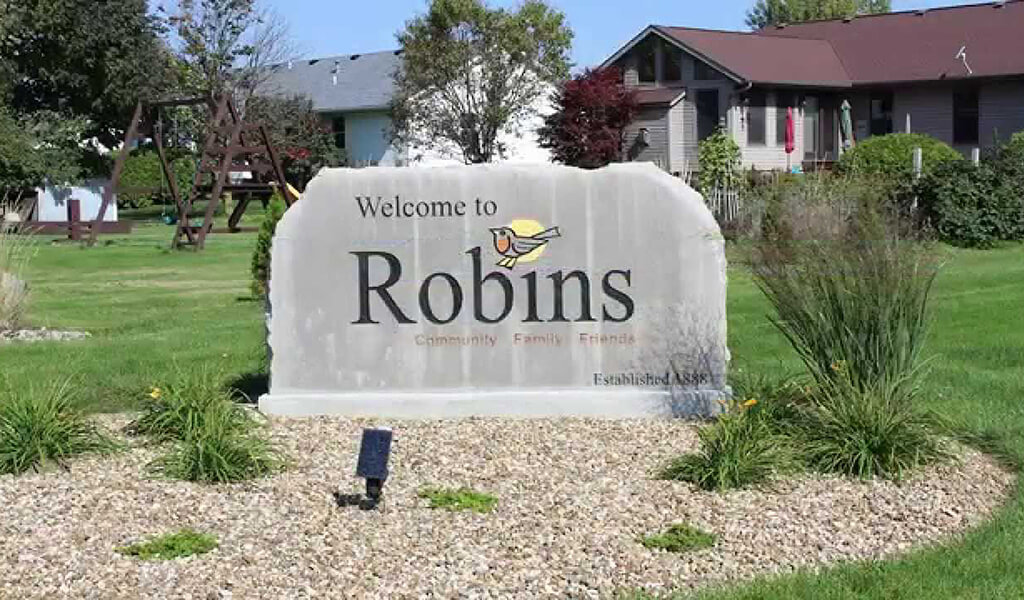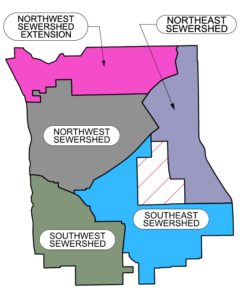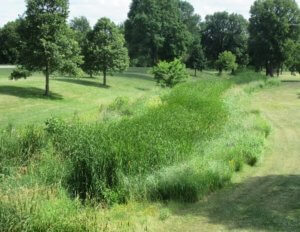
Snyder & Associates Helps City of Robins Plan for a Successful Future
Known for its small-town character and charm, Robins is a welcoming community situated on the northern outskirts of the Cedar Rapids metro area. This Iowa town offers many of the same benefits of big city living in a smaller package. As word spread about the appeal of this community, Robins has experienced a steady increase in population over the last two decades. Recognizing the need for proactive measures to handle future growth, city leaders enlisted the professionals with Snyder & Associates to compile a comprehensive infrastructure report. This report developed a snapshot of current infrastructure needs and created a step-by-step plan to guide the community going forward.
Comprehensive Infrastructure Plan Allows for Successful Growth
Having a detailed infrastructure plan in place provides valuable information, consistent direction, and predictability to members of the community, developers, and city staff alike. The long‐term model outlined in this report was created as a tool to steer city expansion efforts. It likewise prepares community leaders for evolving and unforeseen infrastructure challenges while preventing potentially costly repairs or corrections.
Throughout the report, our planning team developed viable strategies to address current infrastructure needs, accommodate new growth and development, and fund forward-looking projects. We prioritized goals by reviewing and expanding upon previously studied infrastructure systems. This was accomplished by analyzing topography and future land use mapping, establishing an inventory of existing systems usage and capacity, coordinating growth with city staff and utility companies, and estimating future needs.
Detailed Infrastructure Breakdown by Planning Section
The city’s four essential infrastructure systems — wastewater collection, water distribution, transportation network, and stormwater management — were studied and addressed in individual, detailed sections throughout the report. Tailored to each category, the sections provide a breakdown of all current infrastructure systems, our team’s design recommendations, and a prioritized implementation plan to meet the established goals.
Wastewater Collection
Both wastewater collection and conveyance are critical components to consider for effective infrastructure planning. To that end, our experts examined areas of potential development using sewer-shed data pulled from existing topographical sources. This information was then drawn upon to establish practical sewer system design criteria.
Currently, the city provides wastewater services to a combination of residential, commercial, and industrial customers. As part of the report compilation, our team extrapolated the city’s current land usage by a factor of four to anticipate future wastewater collection system demands. This would ensure the system meets the city’s needs for years to come. Based on these carefully established forecasts, improvement and expansion recommendations were created and prioritized by numerous factors. Through this process, our team identified 23 wastewater collection system improvement projects and categorized them by short-, intermediate-, and long-term timeframes.
Water Distribution
Much like wastewater collection, the quality and adequate supply of a community’s drinking water are also vital components to the health of residents. The development of the water distribution section focused on identifying specific geographic regions with the greatest potential for growth. Within each of these regions, water demand projections were set based on appropriate land-use guidelines and the designated categories of user consumption.
As part of the infrastructure report, the Snyder & Associates team led a review and performed a hydraulic analysis of the city’s current water distribution systems. This review and analysis resulted in detailed goals for each water segment and multiple recommendations for new facilities in some cases. These goals were again prioritized as short-, intermediate-, and long-term goals, as well as including an ultimate buildout plan. The establishment of these water distribution priorities creates a clear plan of action for city leaders.
Transportation Networks
Transportation networks are typically viewed as a high priority concern for residents of most communities. A transportation infrastructure inventory accounts for the physical components and societal impacts of network corridors and is essential for a community’s long-term prosperity. Roadway and transportation improvements, including updates and expansions within and beyond city limits, were considered. Our team also classified the existing and future roadways to designate those marked for multimodal upgrades and “Complete Street” solutions.
Our comprehensive approach to design considers all modes of transportation, including pedestrian and bicycle mobility. Multiple design elements and guidelines were outlined in our analysis, including bike paths, sidewalks, and multi-purpose trails. The inclusion of these amenities in the report makes them easy additions in the future when the city feels the time is right. These thoughtfully planned features aim to increase safety, provide local users with a more enjoyable experience, and allow for more direct connectivity throughout the community.
Stormwater Management
Detention basin consolidation and best maintenance practices were our team’s primary focus areas concerning the city’s stormwater conveyance system. Where possible, the addition of natural conveyance corridors was recommended to reduce maintenance requirements and to incorporate native grasses. Since this option is not feasible for all areas of the community, both engineered and hybrid conveyance systems were offered for areas where the terrain or water flow prohibits the establishment of natural corridors. All of these design options were created to reduce flooding concerns and the risk of future property damage.
In coordination with the stormwater conveyance, the city’s detention basin system was also analyzed. Currently, a mix of private and public detention basins dot the city’s landscape. Although these function satisfactorily, the implementation of a regional basin system is strongly desired by city leaders. To meet the requests of our client, our team researched and selected areas where these regional basins would be appropriate. This consolidation effort would increase maintenance efficiency and potentially create additional recreational opportunities for residents.
Funding Assistance Provides Cost Savings for the Community
The creation of an infrastructure improvement plan is the first step towards successful community growth. However, implementing specific recommendations in the plan requires a sustainable funding pathway. To address this concern, cost opinions were included for each recommendation to better prepare the city for budgeting and financial assistance planning.
Additionally, the Snyder & Associates team included multiple funding assistance options specific to each infrastructure category. These options include taxation measures, bond sales, state and federal grants, and State Revolving Funds (SRF). Our team is well-versed when it comes to navigating the numerous financial options available and finding the right funding program for each specific project.
Comprehensive Planning Today for a Successful Tomorrow
The presentation of the report’s contents to the City Council for approval and implementation was halted by the COVID-19 outbreak. When city leaders ease back into normal day-to-day services and activities, the presentation and adoption of this report will be a top priority for council members.
When this proactive plan is fully implemented, the City of Robins will be well-positioned to address future growth in an orderly and progressive manner. At Snyder & Associates, our goal is to consistently provide clients with services that are forward-thinking, sustainable, and cost-effective. We help communities plan responsibly and we work tirelessly to create strong relationships while appreciating and enhancing all of the unique aspects that make each community home.




